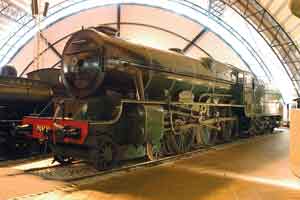MEADB—STEAM LOCOMOTIVE NO. 800
Published in Artefacts, Issue 4 (July/August 2022), Volume 30By Lar Joye

Above: The Meadb, one of three large and powerful steam locomotives built in the Inchicore railway works in the late 1930s, on display in the Ulster Transport Museum. (Ulster Transport Museum)
Writing in 1968, Prof. J.J. Lee remarked of Ireland’s railway system: ‘Before 1850 economic development had been hindered by an underdeveloped transport network. Since 1850 Ireland has been an underdeveloped economy with a highly developed transport system.’ By 1914 there were over 5,000km of railway tracks operated by 46 companies. The first line was the 8km Dublin to Kingstown route, which opened in 1834, but the main railway network was built during the Famine between 1845 and 1853, when Dublin was connected with Cork, Galway and Belfast. The railway changed the rural economy, affected rural diet, introduced tea, expanded the postal system, brought consumerism and, of course, allowed one million emigrants by 1914 to leave the island.
Many of the trains used on the system were built in Ireland by the various railway companies. Celebrating its 175th anniversary this year, the Inchicore railway works was opened by the Great Southern and Western Railway in 1846. In the late 1930s the three largest and most powerful steam engines were built in Inchicore and the Meadb is the only one surviving today, on display in the Ulster Transport Museum, which is part of National Museums NI. Weighing over 130 tons, the three locomotives were designed to run from Dublin to Cork but never achieved their full potential owing to the fuel crisis during the Emergency (1939–45) and the arrival of diesel trains. One historian has noted that ‘the operating rationale and commercial justification for these majestically impressive machines will for ever remain one of those great mysteries of the steam locomotive story’.
Meadb operated from 1939 to 1959, running over 480,000 miles in service and having a record speed of 96mph. In the 1960s Coras Iompair Éireann (CIE) donated Meadb to the Belfast Transport Museum, which later merged with the Ulster Folk Museum. As we celebrate the centenary of the creation of the Free State, the museum sector in Ireland remains small, mainly volunteer-run and under-funded, and still does not have a State-funded national transport museum collecting railway, road or aviation vehicles. A large number have been preserved, however, by a variety of State bodies and volunteer groups, including the Railway Preservation Society of Ireland, which has been operating regular steam trips since 1964 (https://www.steamtrainsireland.com/), while the Railway Records Society has nationally important archives of Ireland’s railway history.
Lar Joye is Heritage Officer of Dublin Port.
















